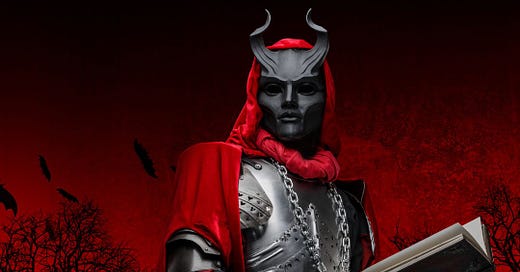Unlock Your Gothic Archetypes and Confront Your Inner Demons
Self-knowledge may lie hidden in the pages of Gothic literature
What if the key to unlocking your true self lies within the dark, mysterious pages of Gothic literature? Could exploring eerie narratives lead you to a deeper understanding of your mind, ultimately guiding you toward a more fulfilling personal and professional life?
After years of exploring Gothic literature, I’ve come to believe this genre holds unparalleled power to reflect the deep complexities of the human mind. In this article, I’ll delve into how unlocking your inner Gothic archetypes, through a Jungian lens, can help you confront your inner demons and discover your authentic self.
The Gothic and the Self: A Journey Beneath the Surface
Gothic literature, whether in books, films, or art, taps into something primal within us. From the haunting landscapes of Wuthering Heights to the dark enchantment of Beauty and the Beast, these works stir emotions, fears, and desires that often defy explanation.
My fascination with the macabre began in childhood, when shadowy figures and eerie settings captured my imagination. Over the years, I realised these Gothic tales mirror the landscapes of the human psyche, helping us confront our fears and navigate the complexities of our inner worlds.
Gothic settings—abandoned castles, haunted houses, and dark corridors—are more than mere plot devices. They represent the locked rooms in our minds, the parts of ourselves we fear to explore. This genre, through its symbols and metaphors, can guide us on a journey into the unconscious, revealing hidden truths about who we are.
Confronting Your Inner Demons Through Gothic Exploration
Engaging with Gothic narratives allows us to confront our inner demons, much like an analyst would interpret a dream. Each story offers clues and riddles that, when pieced together, reveal a personal development pattern unique to you.
Consider Heathcliff from Wuthering Heights. Many readers are drawn to him, not only for his dark charisma but because he embodies the Shadow archetype, but also the Animus—two of the most recognisable archetypes in Jungian psychology. Characters like Heathcliff reflect our repressed fears and desires, giving us a chance to confront the parts of ourselves we often keep hidden.
The Gothic as a Mirror to the Psyche
Gothic literature isn’t just about haunted houses or supernatural entities—it’s a psychological exploration of fear, repression, and the unknown. By engaging with these stories, we can begin to ask ourselves why we are drawn to certain characters or scenarios. What do they reveal about our inner world?
Jungian concepts, such as the Collective Unconscious, Archetypes, and Individuation, offer a powerful lens to interpret these stories. They help us see Gothic narratives not merely as fiction but as reflections of our internal struggles.
Key Jungian Concepts in Gothic Literature:
The Collective Unconscious: The shared part of the unconscious mind where universal archetypes reside.
Archetypes: Recurring figures in literature, dreams, and myths, such as the Hero, the Shadow, and the Trickster.
Individuation: The process of integrating all parts of your personality, including the shadowy and uncomfortable ones, to become your true self.
Unlocking Your Inner Gothic Archetypes
Exploring Gothic literature through a Jungian lens is an invitation to confront hidden aspects of ourselves. Some archetypes play an important role in our psychological growth. Here are some examples:
The Shadow:
Embodied by characters like Heathcliff or Frankenstein’s monster, the Shadow archetype represents the repressed fears and desires we hide from ourselves. Confronting the Shadow helps us acknowledge these hidden parts instead of projecting them outward.
The Hero:
The Hero archetype reflects our higher potential and courage. In Gothic literature, the Hero often faces terrifying circumstances, symbolising our journeys through fear and uncertainty.
The Anima/Animus:
These archetypes represent the feminine and masculine aspects of our psyche. Gothic stories, such as Dracula and Wuthering Heights, blur these gendered lines, encouraging us to embrace the balance within.
The Trickster:
The Trickster brings chaos and disruption, forcing us to confront uncomfortable truths. Characters like Dracula himself embody this archetype (among others), reflecting life’s unexpected twists and the lessons they bring.
The Wise Old Man/Woman:
In moments of chaos, the Wise Old Man or Woman archetype offers wisdom and guidance. By connecting with this archetype, we can trust our inner wisdom and navigate difficult times with clarity.
How Gothic Archetypes Reflect Personal Growth
Unlocking these archetypes in Gothic literature can lead to deep self-awareness, healing, and personal transformation. By confronting our inner demons, balancing the psyche, and tapping into the unconscious, we can achieve a more integrated and authentic version of ourselves.
Engaging with Gothic stories allows us to:
Confront repressed emotions
Overcome limiting beliefs
Find inner strength in adversity
Explore existential questions about life and death
Cultivate inner wisdom
Final Thoughts
Gothic literature offers us more than eerie thrills—it provides a mirror to the darkest corners of our psyche. By unlocking your inner Gothic archetypes, you can confront your fears, transform your understanding of yourself, and embark on a journey of profound personal growth.
Did you like this article? Would you like to know more? You can check my course Exploring The Gothic Psyche: Jungian Concepts In Gothic Literature; an Introspective Journey To Connect With Your Internal Figures
You can also subscribe to have access to more detailed content.
Thanks for reading,
Alice





